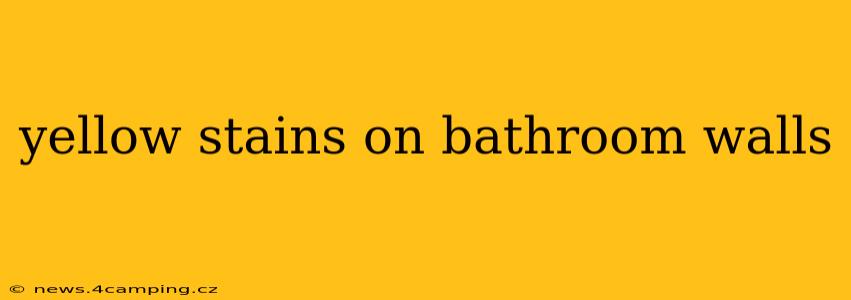Yellow stains on bathroom walls are a common—and unsightly—problem. They can detract from the overall aesthetic of your bathroom and signal underlying issues. Understanding the cause of these stains is the first step in effectively removing them and preventing future occurrences. This comprehensive guide will explore the various reasons behind yellow discoloration, offering effective solutions and preventative measures.
What Causes Yellow Stains on Bathroom Walls?
Several factors contribute to the appearance of yellow stains on bathroom walls. Identifying the source is crucial for selecting the appropriate cleaning method.
1. Mold and Mildew:
This is often the most common culprit. Mold and mildew thrive in damp environments, and bathrooms are particularly susceptible due to high humidity from showers and baths. These fungi produce yellow, orange, or brown stains, often accompanied by a musty odor. Severe mold infestations require professional remediation.
2. Hard Water Stains:
Hard water, rich in minerals like calcium and magnesium, can leave behind unsightly yellow or brownish stains, especially around showerheads and faucets. These mineral deposits build up over time, creating a persistent discoloration.
3. Nicotine Residue:
If you or previous occupants smoked in the bathroom, nicotine residue can seep into the walls, leaving behind yellow stains that are difficult to remove. This is particularly prevalent in older homes.
4. Water Leaks:
Unnoticed water leaks behind the walls can lead to significant damage and discoloration. The water can stain the wall itself, or it can encourage mold and mildew growth, further exacerbating the problem. Yellowing in this case often indicates water damage that needs professional attention.
5. Rust:
Rust stains, often appearing orange-brown or yellow, can occur if there’s metal corrosion within the wall structure or from leaky pipes.
6. Age and Discoloration:
Over time, paint can simply yellow due to exposure to sunlight and humidity. This is a more gradual process than the other causes mentioned above.
How to Remove Yellow Stains on Bathroom Walls: A Step-by-Step Guide
The best method for removing yellow stains depends on their cause. Always test any cleaning solution on an inconspicuous area first to avoid damaging the paint or wall surface.
1. Cleaning for Mold and Mildew:
- Mild Solution: For minor mold and mildew, a solution of bleach and water (1:10 ratio) can be effective. Apply with a spray bottle, let it sit for 10-15 minutes, and then scrub with a stiff brush. Rinse thoroughly.
- Commercial Cleaners: Several commercial mold and mildew removers are available. Follow the manufacturer's instructions carefully. Always wear gloves and eye protection when using these products.
- Severe Infestation: If mold and mildew are extensive, professional remediation is recommended.
2. Cleaning for Hard Water Stains:
- Vinegar: White vinegar is a natural and effective cleaning agent for hard water stains. Apply undiluted vinegar to the stains, let it sit for 30 minutes, then scrub with a brush and rinse.
- Commercial Cleaners: Many commercial cleaners specifically target hard water stains. Follow the product instructions.
3. Cleaning for Nicotine Residue:
Nicotine stains are notoriously stubborn. You may need to try several methods:
- TSP (Trisodium Phosphate): TSP is a powerful cleaner, but it's important to follow safety precautions and wear appropriate protective gear.
- Commercial Cleaners: Look for cleaners specifically designed to remove nicotine stains.
- Repainting: In severe cases, repainting the wall may be necessary.
4. Addressing Water Leaks:
If you suspect a water leak, addressing the leak itself is paramount. Contact a plumber to locate and repair the source of the leak before attempting any cleaning.
Preventing Yellow Stains on Bathroom Walls
Preventing yellow stains is much easier than removing them. Here are some preventative measures:
- Good Ventilation: Ensure adequate ventilation in your bathroom to reduce humidity. Use an exhaust fan during and after showers.
- Regular Cleaning: Clean your bathroom walls regularly to prevent mold and mildew buildup. Wipe down walls after showering to remove excess moisture.
- Prompt Leak Repair: Address any water leaks immediately.
- Caulk Regularly: Caulk around tubs, showers, and sinks to prevent water from seeping behind the walls.
- Choose Mold-Resistant Paint: Consider using mold-resistant paint when repainting your bathroom.
By understanding the causes of yellow stains and implementing these preventative measures, you can maintain a clean, fresh, and stain-free bathroom. Remember, persistent or extensive stains may require professional assistance.
